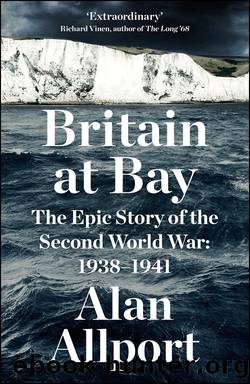Britain at Bay: The Epic Story of the Second World War: 1938-1941 by Alan Allport

Author:Alan Allport
Language: eng
Format: epub
Publisher: Profile EBooks
Published: 2020-11-15T00:00:00+00:00
17
MARGINS
âWe crossed the Thames and the Medway, leaving the towns with their moorings of toy balloons far beneath.â It was the morning on 28 August 1940, and Jim Bailey was a twenty-year-old Pilot Officer in RAF Fighter Commandâs 264 (Madras Presidency) Squadron, taking part in his first combat action. Twelve of 264âs aircraft had been scrambled from the RAF base at Hornchurch in Essex to intercept a group of German bombers â several dozen Heinkel He 111s â detected heading northwards across the Channel from Calais. It was fifteen days since the Luftwaffe had begun its full-scale, systematic daylight raiding of south-eastern England, attacking RAF airfields in a bid to wear down Fighter Commandâs defences and so achieve local air superiority over Kent and Sussex â perhaps as a prelude to a ground invasion. Two days earlier, twenty-seven of the RAFâs fighters had been destroyed and six pilots killed in massive aerial battles over the Home Counties. German losses were greater still, but they had had larger numbers to begin with. The strain on Fighter Commandâs young airmen was beginning to tell. The outcome of this battle â the âBattle of Britainâ, as Churchill had already named it back in July â seemed very much in the balance.
In the distance, Bailey could see a drove of Heinkels approaching from the south-east, accompanied by dusty splatters of anti-aircraft fire. Far above them, âsmall black motes in the empyreanâ, were the German Bf 109 escort fighters, buzzing about sinisterly. Baileyâs orders were to ignore them and to stay rigidly in formation to attack the bombers, trusting that other nearby British fighters would deal with the Luftwaffe escorts. âThen it happenedâ, he said:
They were about twenty or thirty large Heinkels flying in sections of three, line astern. My gunner began to fire. I concentrated on keeping formation, confident that the whole of âBâ Flight was behind, protecting my tail. The four Brownings stuttered above my head. I became excited [â¦] the Heinkels looked as big as elephants.
I had felt jolts or rattles on my own aircraft, and a voice seemed to be saying down the intercom, âIâm wounded.â I flicked over, pulled back on the stick, and spiralled for the ground in a controlled blackout. At ground level I straightened out.
âAre you all right?â I shouted to the air-gunner down our faulty radio. âQuite all right.â âI thought you said you were wounded?â âNo!â he said. âTurn to starboard.â Then the engine died.
With the throttle not responding and only a couple of hundred feet of altitude left between his aircraft and the soil of Kent, Bailey had no choice but to look for an emergency landing site. All the fields below were studded with wooden poles, planted earlier in the summer to thwart German invasion gliders. With all other options exhausted, Bailey brought his aircraft down hard into a hedgerow, just missing some overhanging high-tension cables as he plummeted to a halt. He bloodied his nose on the instrument panel at the moment of collision, but he was otherwise unhurt.
Download
This site does not store any files on its server. We only index and link to content provided by other sites. Please contact the content providers to delete copyright contents if any and email us, we'll remove relevant links or contents immediately.
| Africa | Americas |
| Arctic & Antarctica | Asia |
| Australia & Oceania | Europe |
| Middle East | Russia |
| United States | World |
| Ancient Civilizations | Military |
| Historical Study & Educational Resources |
Magic and Divination in Early Islam by Emilie Savage-Smith;(1500)
Ambition and Desire: The Dangerous Life of Josephine Bonaparte by Kate Williams(1344)
Bohemians, Bootleggers, Flappers, and Swells: The Best of Early Vanity Fair by Bohemians Bootleggers Flappers & Swells- The Best of Early Vanity Fair (epub)(1343)
Papillon by Henry Charrière(1310)
Twelve Caesars by Mary Beard(1256)
Operation Vengeance: The Astonishing Aerial Ambush That Changed World War II by Dan Hampton(1135)
What Really Happened: The Death of Hitler by Robert J. Hutchinson(1128)
London in the Twentieth Century by Jerry White(1112)
Time of the Magicians by Wolfram Eilenberger(1089)
The Japanese by Christopher Harding(1086)
Twilight of the Gods by Ian W. Toll(1084)
Lenin: A Biography by Robert Service(1045)
The Devil You Know by Charles M. Blow(985)
A Social History of the Media by Peter Burke & Peter Burke(936)
Freemasons for Dummies by Hodapp Christopher;(922)
Napolean Hill Collection by Napoleon Hill(902)
Henry III by David Carpenter;(891)
The Churchill Complex by Ian Buruma(881)
The Rise and Triumph of the Modern Self by Unknown(879)
